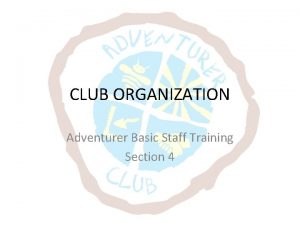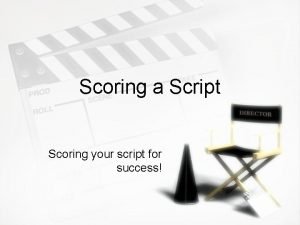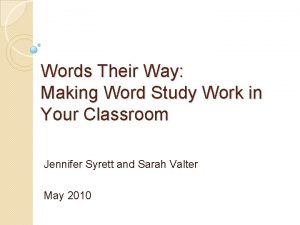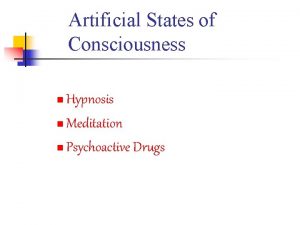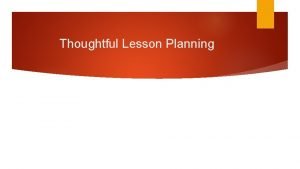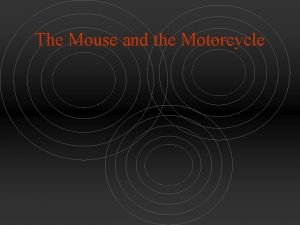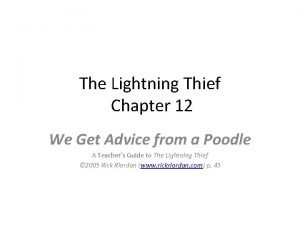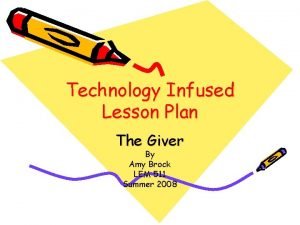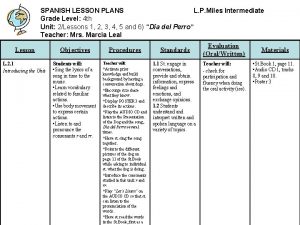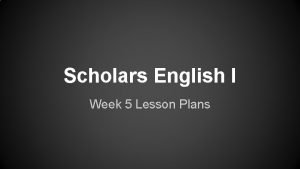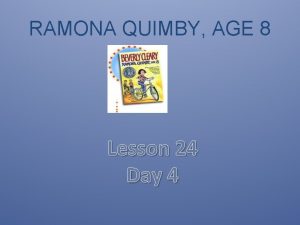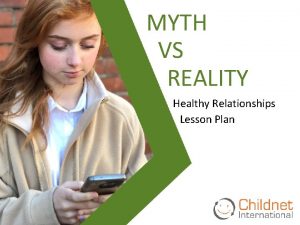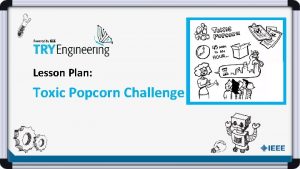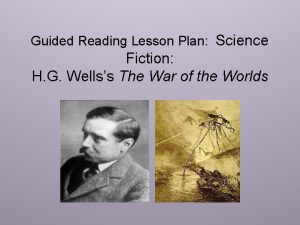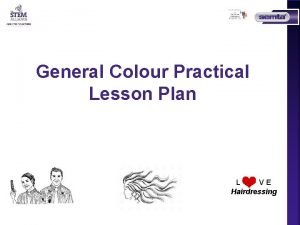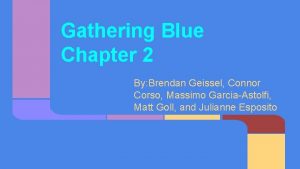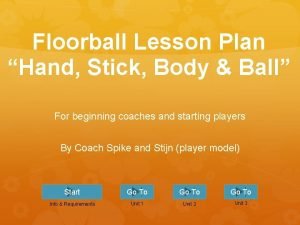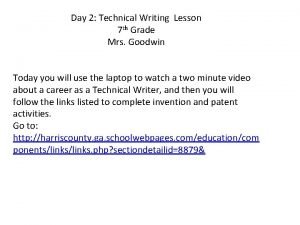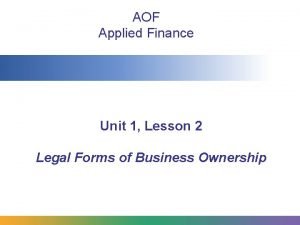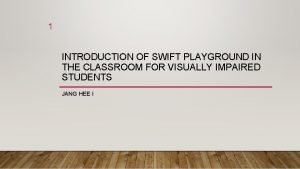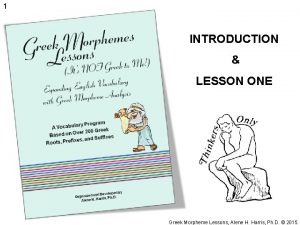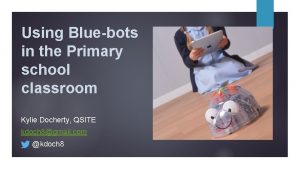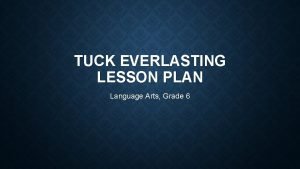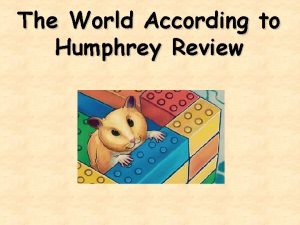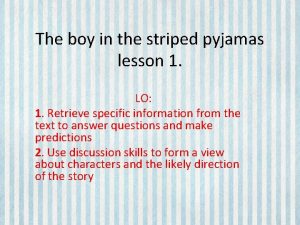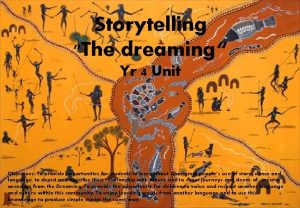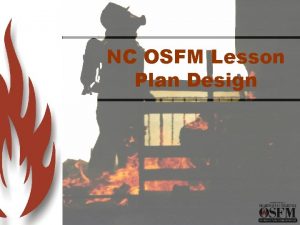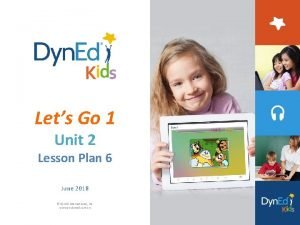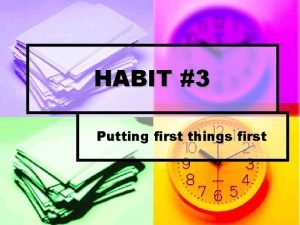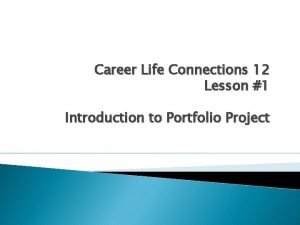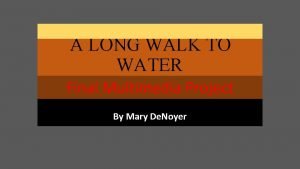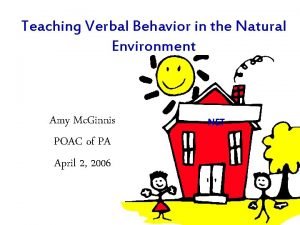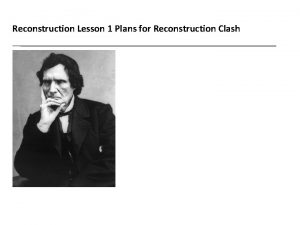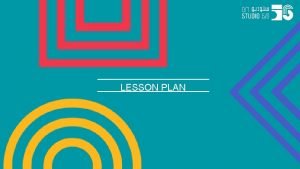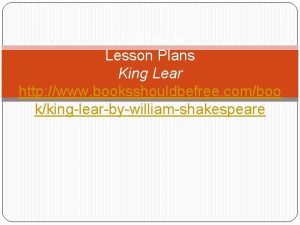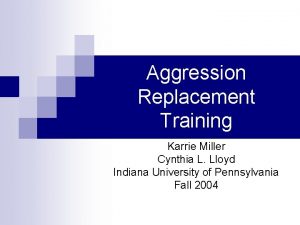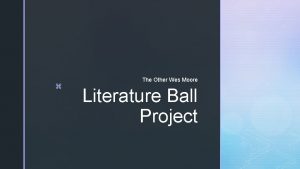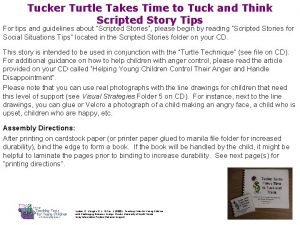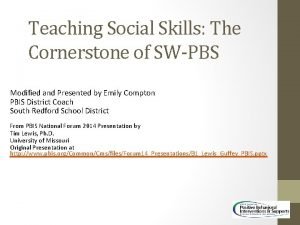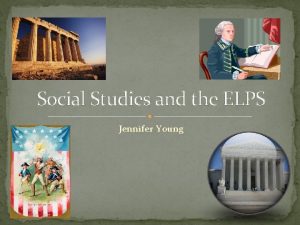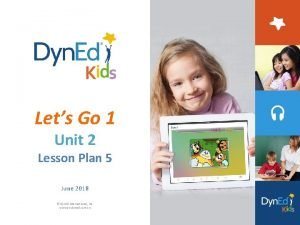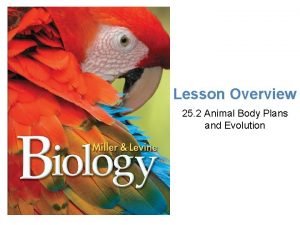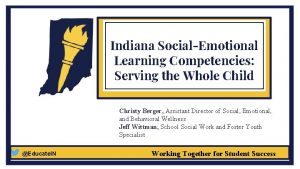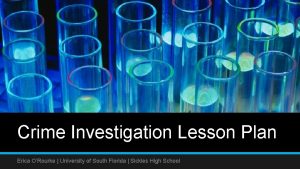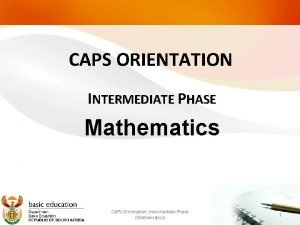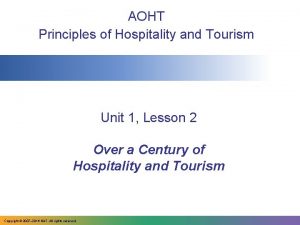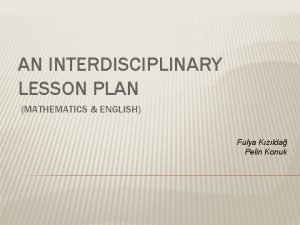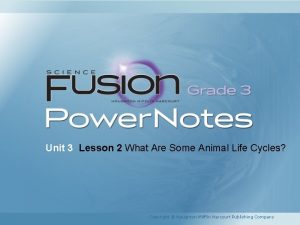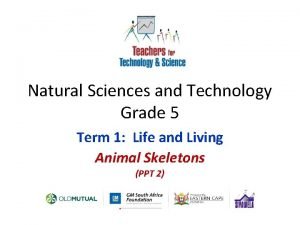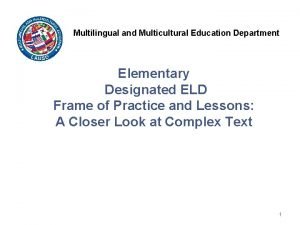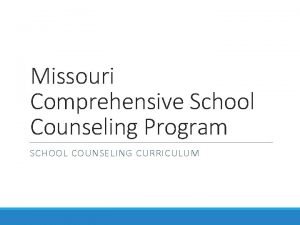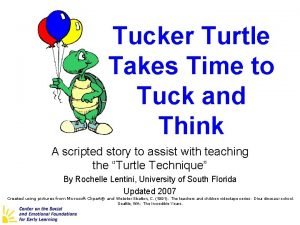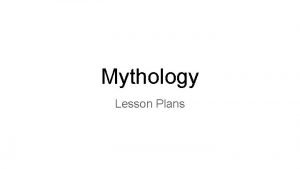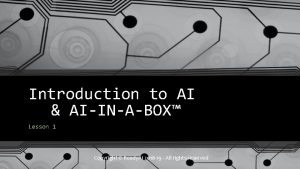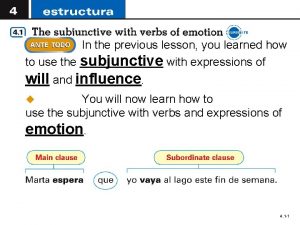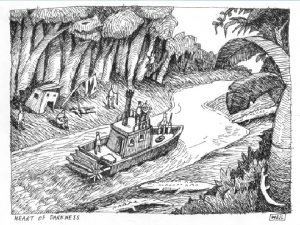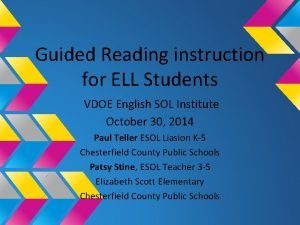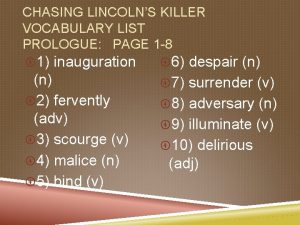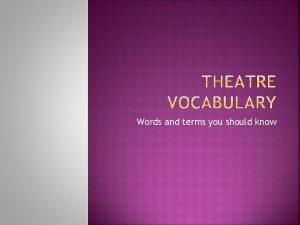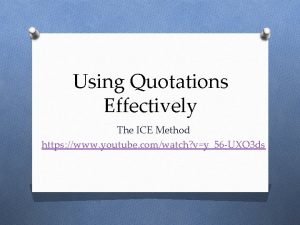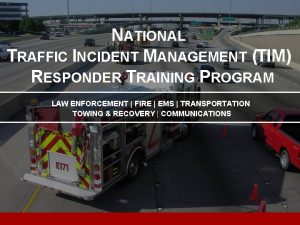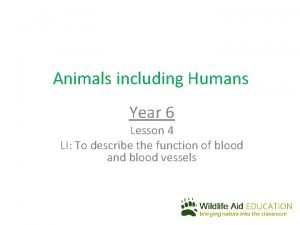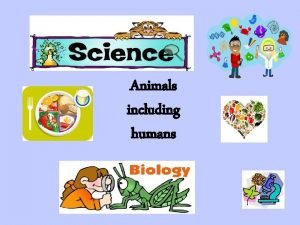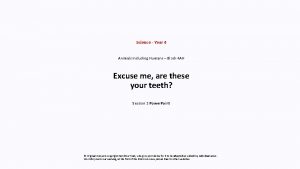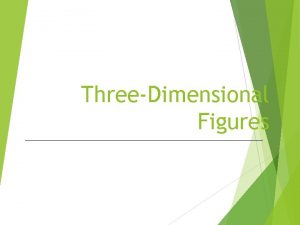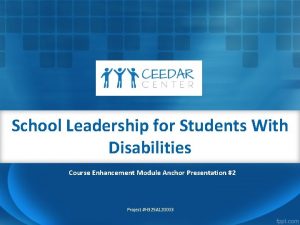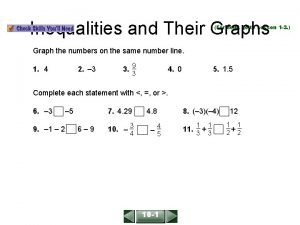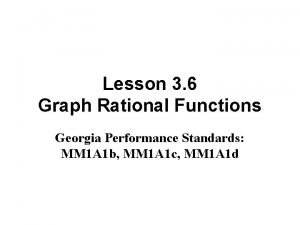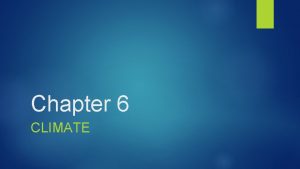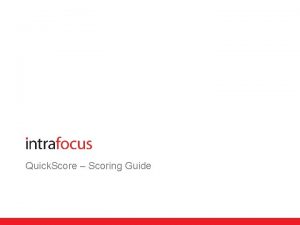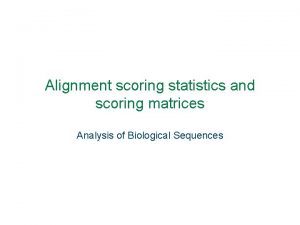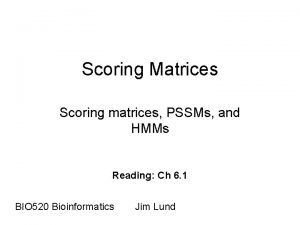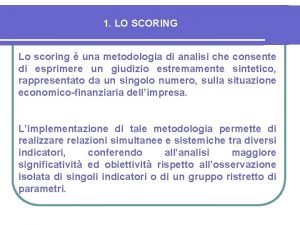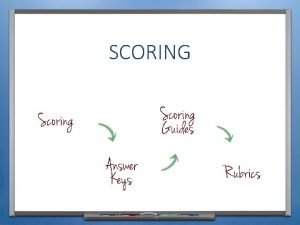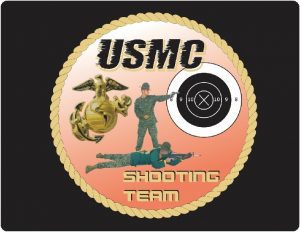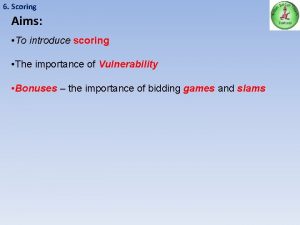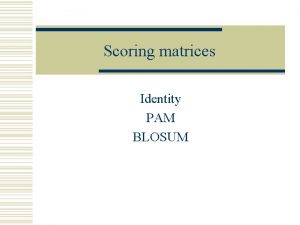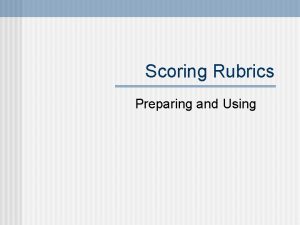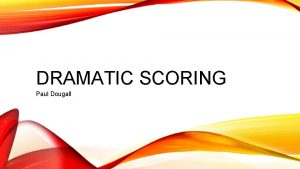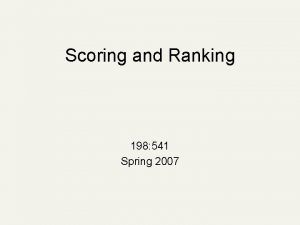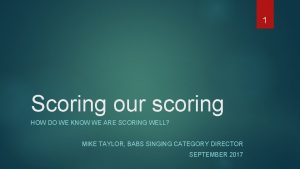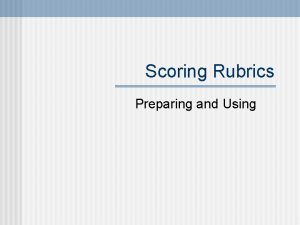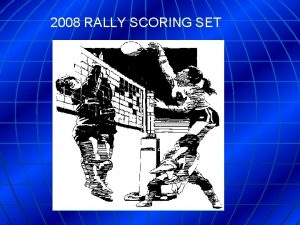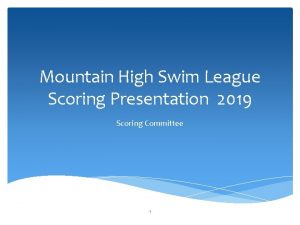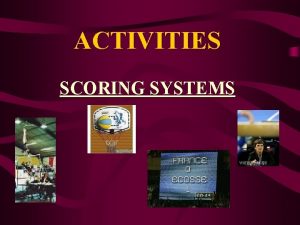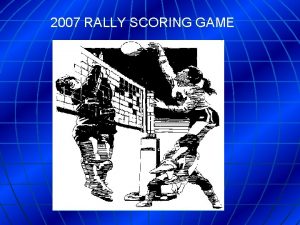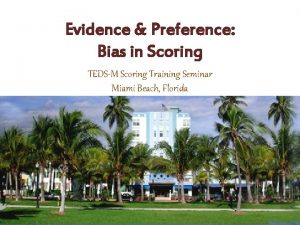Adventurers Against Their Will Lesson Plans including Scoring
















































































































- Slides: 112

Adventurers Against Their Will Lesson Plans including Scoring Rubrics, and Alignments to Florida, Common Core, and C 3 (NCSS) Standards Book Written by Joanie Schirm Lesson Plans Developed by A Pass Educational Group, LLC 1 Right arrow or click to continue

Right arrow or click to continue

Citation and Purchase Info Schirm, Joanie Holzer. Adventurers against Their Will: Extraordinary World War II Stories of Survival, Escape, and Connection--unlike Any Others. First edition, revised. [Orlando, Fla. ]: Peli. Press, 2014. Available for purchase in Print Paperback and EBook from the following online international retailers: Click here: Amazon International: BR, CA, FR, DE, IT, JP, ES, UK Barnes and Noble Books-A-Million 3 Right arrow or click to continue

Table of Contents Lesson 1 Lesson 2 Lesson 3 Lesson 4 Lesson 5 Lesson 6 Scoring Rubric for Lessons 1 -6 Lesson 7 (Performance Task) Scoring Rubric for Lesson 7 4 Right arrow or click to continue

LESSON 1 SETTING THE STAGE 5 Right arrow or click to continue

Lesson 1: Setting the Stage 6 Right arrow or click to continue

Lesson 1: Setting the Stage This lesson begins by exploring themes that frequently drive the stories included in Adventurers Against Their Will. The lesson begins by asking students to reflect on what they already know about the Holocaust, both individually and as a group. Terms of persecution are discussed. Then, students work in small groups to create thoughtful and meaningful definitions. Following small-group presentations/reports of key terms, students consider other historical events to which these terms might apply and offer their perspective on these events. Finally, students will reflect on what they have learned. 7 Right arrow or click to continue

Lesson 1: Setting the Stage A K-W-L chart will be started in Lesson 1 and kept throughout the unit. In addition, reflection questions will be asked at the end of each lesson. Students are encouraged to keep a journal with their answers to these reflection questions, as their opinions may change over the unit. As they read, encourage students also to record their own questions, observations, reactions, opinions, and feelings. 8 Right arrow or click to continue

Lesson 1: Setting the Stage Learning Objectives Students will consider the broader implications of the Holocaust, including other genocides, as well as ways in which people perpetuate stereotypes or prejudices, discriminate against other groups, or are discriminated against. The lesson engages students in critical thinking to analyze the causes and effects of Hitler’s rise to power. Students will be able to: ● Define words associated with hatred and discrimination. ● List historical examples of discrimination against and persecution of minority groups. ● Discuss these words and their meanings within both a modern and historical context. 9 Right arrow or click to continue

Lesson 1: Setting the Stage Florida Social Studies Standards: SS. 912. W. 7. 8: Explain the causes, events, and effects of the Holocaust (1933 -1945) including its roots in the long tradition of anti-Semitism, 19 th century ideas about race and nation, and Nazi dehumanization of the Jews and other victims. SS. 912. W. 9. 3: Explain cultural, historical, and economic factors and governmental policies that created the opportunities for ethnic cleansing or genocide in Cambodia, the Balkans, Rwanda, and Darfur, and describe various governmental and nou wanton-governmental responses to them. SS. 912. P. 10. 12: Examine how perspectives affect stereotypes and treatment of minority and majority groups in society. SS. 912. P. 10. 6: Discuss how privilege and social power structures relate to stereotypes, prejudice, and discrimination. SS. 912. P. 9. 8: Discuss the nature and effects of stereotyping, prejudice, and discrimination. SS. 912. C. 4. 3: Assess human rights policies of the United States and other countries. 10 Right arrow or click to continue

Lesson 1: Setting the Stage Common Core State Standards (CCSS) for English Language Arts & Literacy in History/Social Studies: ELA-RH. 11 -12. 4: Determine the meaning of words and phrases as they are used in a text, including analyzing how an author uses and refines the meaning of a key term over the course of a text. ELA-RH. 11 -12. 7: Integrate and evaluate multiple sources of information presented in diverse formats and media (e. g. , visually, quantitatively, as well as in words) in order to address a question or solve a problem. 11 Right arrow or click to continue

Lesson 1: Setting the Stage National Council for the Social Studies (NCSS) C 3 Framework Standards: D 1. 1. 9 -12. Explain how a question reflects an enduring issue in the field. D 2. Civ. 10. 9 -12. Analyze the impact and the appropriate roles of personal interests and perspectives on the application of civic virtues, democratic principles, constitutional rights, and human rights. D 2. His. 5. 9 -12. Analyze how historical contexts shaped and continue to shape people’s perspectives. D 2. His. 14. 9 -12. Analyze multiple and complex causes and effects of events in the past. D 4. 6. 9 -12. Use disciplinary and interdisciplinary lenses to understand the characteristics and causes of local, regional, and global problems; instances of such problems in multiple contexts; and challenges and opportunities faced by those trying to address these problems over time and place. D 4. 7. 9 -12. Assess options for individual and collective action to address local, regional, and global problems by engaging in self-reflection, strategy identification, and complex causal reasoning. 12 Right arrow or click to continue

Lesson 1: Setting the Stage Preparation Materials Required: - Chalkboard/chalk or whiteboard/markers - Poster board and markers for small groups 13 Right arrow or click to continue

Lesson 1: Setting the Stage Lesson Procedure Build Background 20 minutes DOK 1 -3 1. Introduce the topic by telling students that the class is going to be reading a book that shares the experiences of people who lived in Germany during the World War II and those who emigrated prior to the Holocaust. Ask students to create a K-W-L chart and to fill in the first column with things that they know about the Holocaust. Allow students a few minutes to complete this step. 2. As a class, brainstorm words that come to mind when students think of the Holocaust. List responses on the board. 3. When you have generated a list, display the following quote: "The road to Auschwitz was built by hate, but paved with indifference. " 14 Right arrow or click to continue

Lesson 1: Setting the Stage Lesson Procedure Build Background 20 minutes DOK 1 -3 4. Discuss what the quote means. (You may have to explain that Auschwitz was one of the biggest concentration camps, where the Nazis sent Jews and other “undesirables”. ) Ask students whether they agree or disagree with the quote. 5. Focus attention on hatred, what it means, and where it comes from. Ask: “Why do people hate other people or groups of people? Where does hatred of people who are different from us come from? ” 6. Then discuss indifference. It is unlikely that students will have listed indifference as one of the words during their brainstorming session. Encourage students to consider adding this word to the list of words on the board. Ask: “How does this change the way you look at what happened? Does it affect how you look at who is responsible? ” 15 Right arrow or click to continue

Lesson 1: Setting the Stage Small Group Activity 10 minutes DOK 2 -3 1. Use a creative grouping strategy to break students into groups of four or five. Provide each group with one of the following words: ● ● ● ● prejudice intolerance discrimination persecution Anti-Semitism racism propaganda stereotype [Note: You may instead use the words that students have listed on the board and/or add these to the list of words listed here. ] Have students discuss the word they have been assigned. Students should consider how the word makes them feel. Then, students should also write a definition of the word (consulting dictionaries or reference materials as needed) and examples. Students should be prepared to report on their discussion. 16 Right arrow or click to continue

Lesson 1: Setting the Stage Large Group Activity 20 minutes DOK 3 -4 1. Have a volunteer from each group provide you with the definition of the word they have been assigned and examples they discussed. As a class, revise the definition if needed to result in an agreed-upon definition for each word. Post the words and definitions where everyone can see them. Tell students that you will revisit the definitions as you read Adventurers Against Their Will. 2. Lead a discussion of the words. Ask students how each of the concepts relates to hatred. Ask: “Is the concept a cause or effect of hatred? ” Guide students to make connections among the concepts represented by each of the words. 3. Discuss the events or examples that students have discussed in their small groups. Which events or examples came up more than once? Guide students to understand that persecution has happened in many places over many years. Discuss the examples that students present. You may want to mention these examples: ● ● ● ● conquest of South America Indian Removal Act of 1828 Armenian genocide, beginning in 1915 the Jim Crow South in the United States South African Apartheid Rwanda in the early 1990 s Bosnia in the late 1990 s Iraq and Syria in the 2010 s 17 Right arrow or click to continue

Lesson 1: Setting the Stage Small Group Activity 10 minutes DOK 2 -3 1. Use a creative grouping strategy to break students into groups of four or five. Provide each group with one of the following words: ● prejudice ● intolerance ● discrimination ● persecution ● Anti-Semitism ● racism ● propaganda ● stereotype [Note: You may instead use the words that students have listed on the board and/or add these to the list of words listed here. ] Have students discuss the word they have been assigned. Students should consider how the word makes them feel. Then, students should also write a definition of the word (consulting dictionaries or reference materials as needed) and examples. Students should be prepared to report on their discussion. 18 Right arrow or click to continue

Lesson 1: Setting the Stage Individual Activity 1. 10 minutes DOK 3 Have students return to their K-W-L charts and add at least one thing to the “L” column. Ask them also to add a question to the “W” column. 1. Conclude by asking students to reflect on the day’s lesson. Ask them to write and record the following questions: ● Which concept or concepts do you think contributes most toward hatred? ● What do you think we can do to address people’s hatred toward other groups? ● What do you think we can do about indifference? Note: If students do not have enough time to complete the K-W-L and reflection in class, one or both of these may be assigned as homework. Remind students to bring their K-W-L sheets and journal to class each period, as they will add to them for the duration of the unit. 19 Right arrow or click to continue

Lesson 1: Setting the Stage Homework Assign as homework the first two chapters of Adventurers Against Their Will. Ask students to take notes on what they read and to come to the next class prepared to discuss the reading. Assessment Consider students’ participation in large-group discussions to assess their ability to define terms and make connections among ideas. Use small-group work and presentations to assess students’ ability to research and identify relevant information. Review the responses to the reflection questions to assess whether students recognize the complexity of the factors that contribute to persecution and discrimination. 20 Right arrow or click to continue

LESSON 2 HISTORICAL CONTEXT 21 Right arrow or click to continue

Lesson 2: Historical Context 22 Right arrow or click to continue

Lesson 2: Historical Context This lesson provides context for the letters and stories that are told in Adventurers Against Their Will. The lesson focuses on the rise of the Nazi Party and the impact of Hitler’s expansionist goals on Europe. The lesson begins by asking students to reflect on what they have read in the first two chapters. Then, students work in small groups to create a timeline of events. Following small-group presentations of key events, students reflect on what they have learned. 23 Right arrow or click to continue

Lesson 2: Historical Context Learning Objectives Students will learn about the context in which the Holocaust took place, with a focus on the progression of events in Nazi Germany. Students will also consider the broader implications, including other genocides, as well as the smaller ways in which people perpetuate stereotypes or prejudices, discriminate against other groups, or are discriminated against. The lesson engages students in critical thinking to analyze the causes and effects of Hitler’s rise to power. Students will be able to: ● ● Identify ways that the rights of Jews and other groups were restricted in Germany and German-controlled territories in the 1930 s and 1940 s. Discuss factors contributing to the persecution of Jews and other groups in Germany. Discuss events leading up to the Holocaust. Identify countries and areas directly affected by Germany’s expansionist policies. 24 Right arrow or click to continue

Lesson 2: Historical Context Florida Social Studies Standards: SS. 912. W. 1. 1: Utilize historical inquiry skills and analytical processes. Use timelines to establish cause-and-effect relationships of historical events. SS. 912. A. 6. 8/SS. 912. W. 7. 8: Explain the causes, events, and effects of the Holocaust (1933 -1945) including its roots in the long tradition of anti-Semitism, 19 th century ideas about race and nation, and Nazi dehumanization of the Jews and other victims. SS. 912. A. 6. 3: Analyze the impact of the Holocaust during World War II on Jews as well as other groups. SS. 912. W. 7. 6: Analyze the restriction of individual rights and the use of mass terror against populations in the Soviet Union, Nazi Germany, and occupied territories. SS. 912. W. 6: Understand the development of Western and non-Western nationalism, industrialization and imperialism, and the significant processes and consequences of each. SS. 912. G 4. 9: Use political maps to describe the change in boundaries and governments within continents over time. 25 Right arrow or click to continue

Lesson 2: Historical Context Common Core State Standards (CCSS) for English Language Arts & Literacy in History/Social Studies: ELA-RH. 11 -12. 1: Cite specific textual evidence to support analysis of primary and secondary sources, connecting insights gained from specific details to an understanding of the text as a whole. ELA- RH. 11 -12. 3: Evaluate various explanations for actions or events and determine which explanation best accords with textual evidence, acknowledging where the text leaves matters uncertain. ELA-RH. 11 -12. 7: Integrate and evaluate multiple sources of information presented in diverse formats and media (e. g. , visually, quantitatively, as well as in words) in order to address a question or solve a problem. 26 Right arrow or click to continue

Lesson 2: Historical Context National Council for the Social Studies (NCSS) C 3 Standards: D 2. Civ. 3. 9 -12. Analyze the impact of constitutions, laws, treaties, and international agreements on the maintenance of national and international order. D 2. Civ. 5. 9 -12. Evaluate citizens’ and institutions’ effectiveness in addressing social and political problems at the local, state, tribal, national, and/or international level. D 2. Civ. 6. 9 -12. Critique relationships among governments, civil societies, and economic markets. D 2. Civ. 12. 9 -12. Analyze how people use and challenge local, state, national, and international laws to address a variety of public issues. D 2. His. 3. 9 -12. Use questions generated about individuals and groups to assess how the significance of their actions changes over time and is shaped by the historical context. D 2. His. 5. 9 -12. Analyze how historical contexts shaped and continue to shape people’s perspectives. D 2. His. 6. 9 -12. Analyze the ways in which the perspectives of those writing history shaped the history that they produced. 27 Right arrow or click to continue

Lesson 2: Historical Context National Council for the Social Studies (NCSS) C 3 Standards: D 2. His. 14. 9 -12. Analyze multiple and complex causes and effects of events in the past. D 4. 2. 9 -12. Construct explanations using sound reasoning, correct sequence (linear or non-linear), examples, and details with significant and pertinent information and data, while acknowledging the strengths and weaknesses of the explanation given its purpose (e. g. , cause and effect, chronological, procedural, technical). D 4. 6. 9 -12. Use disciplinary and interdisciplinary lenses to understand the characteristics and causes of local, regional, and global problems; instances of such problems in multiple contexts; and challenges and opportunities faced by those trying to address these problems over time and place. D 4. 7. 9 -12. Assess options for individual and collective action to address local, regional, and global problems by engaging in self-reflection, strategy identification, and complex causal reasoning. 28 Right arrow or click to continue

Lesson 2: Historical Context Preparation Materials Required Map of Europe 1935 -1940 Chalkboard/chalk or whiteboard/markers Access to the Internet or research materials for small groups Poster board and markers for small groups 29 Right arrow or click to continue

Lesson 2: Historical Context Lesson Procedure Build Background 5 minutes DOK 1 -3 1. Begin the lesson by asking for general impressions of what students have read. Ask students to record at least one thing they have learned on their K-W-L chart. Allow a few minutes for students to do so, and then ask what facts stood out in the reading. 2. Lead a brief discussion of the first two chapters. Ask: ● Why do you think her father kept the letters? Why do you think he never shared the letters with his family? Do you think he looked at the letters? Why or why not? ● What obstacles did the author face in conducting her research? What do you think drove her to push past these obstacles? Encourage students to identify specific or concrete obstacles, such as having the letters from so many different people, having to translate them, etc. Encourage students to discuss the emotional aspects of research. Guide students to understand that some people shy away from the truth when it is difficult. Ignoring difficult truths perpetuates the problem. 30 Right arrow or click to continue

Lesson 2: Historical Context Lesson Procedure Build Background 5 minutes DOK 1 -3 3. Next, turn attention to the historical context of the letters. Set the stage by telling students that there were over nine million Jews in Europe in 1933, accounting for roughly 1. 7 percent of the total population. German Jews numbered about 500, 000, or less than one percent of the population. 4. Focus on the relationship between the Holocaust and World War II. To make this connection, show one or more maps of Europe to demonstrate Nazi Germany’s territorial aggression, such as the one here (http: //germanhistorydocs. ghidc. org/images/Map_1_english_for_bh-edit. jpg). Have students also view the maps in Adventurers Against Their Will (after Chapter 2). 31 Right arrow or click to continue

Lesson 2: Historical Context Small Group Activity 20 minutes DOK 2 -3 1. Break students into small groups of equal size. Provide the groups with books and documents about World War II and the events leading up to the Holocaust. (Alternatively, have groups conduct research online. ) Assign each group one of the years leading up to the Holocaust (1933– 1943). Groups are to read through the reference materials and look for information about Hitler’s rise to power, the laws and events that restricted the rights of Jews and other groups of people, and other events that they believe contributed to the Holocaust. Note: Depending on the depth and quality of the information and the size of the class, some of these years can be combined. You may also want to assign a group, the time period before 1933 or after 1943. 1. Explain to students that they will make a presentation about the year that they have been assigned. As part of this presentation, students should make a timeline with the major events that took place that year. Distribute poster board and markers to each small group for their part of the timeline. 32 Right arrow or click to continue

Lesson 2: Historical Context Large Group Activity 30 minutes DOK 1 -3 1. Have students post their year on the wall to create a timeline. Then, have each small group make a 3 -5 -minute presentation of the findings from the research, beginning with 1933 (or pre-1933) and going through each year in succession. Encourage students to ask questions of each group. If the groups are unable to answer the questions, make a note of the questions for students to research as part of their homework assignment. Although students should take ownership of their particular year, make sure they have addressed the key events on their timelines. (See the timeline that follows the rubric and/or the timeline at the back of Adventurers Against Their Will. ) 2. After all groups have made their presentations, lead a discussion of the events. Emphasize the fact that the restriction of rights happened gradually over a period of time. 3. Focus attention on the fact that most of these events show things happening to Jews and other groups of people. They show little about how these groups of people responded. Write the word resistance on the board. Ask students what the word means to them. Make a word web of responses. 33 Right arrow or click to continue

Lesson 2: Historical Context Large Group Activity 30 minutes DOK 1 -3 4. Turn attention to historical examples of resistance. Many students may mention examples of violent resistance; fighting physically in some way. Acknowledge these examples, but guide students to recognize other, less obvious forms of resistance, such as continuing to practicing one’s faith, attending school, refusing to abide by laws, or even just continuing to have hope. Writing can also be a form of resistance such as producing underground newspapers, keeping diaries, and letter writing. 5. Explain that in Adventurers Against Their Will, students will come across many forms of resistance. Writing letters is the most obvious form of resistance in the book, but encourage students to look within the letters to note specific ways that the people in the book engage in resistance. 34 Right arrow or click to continue

Lesson 2: Historical Context Individual Activity 5 minutes DOK 3 1. Have students return to their K-W-L charts and add at least one thing to the “L” column. Ask them also to add a question to the “W” column, preferably something that they think they will learn from Adventurers Against Their Will. 2. Conclude by asking students to reflect on the day’s lesson. Ask them to write and record the following questions: ● Of everything you learned today, what did you find the most surprising or upsetting? Why? ● What do you think it takes for people who are persecuted to persevere? Note: If students do not have enough time to complete the K-W-L and reflection in class, one or both of these may be assigned as homework. Remind students to bring their K-W-L sheets and journal to class each period, as they will add to them for the duration of the unit. 35 Right arrow or click to continue

Lesson 2: Historical Context Homework Assign as homework Chapters 3 -4 of Adventurers Against Their Will. Ask students to take notes on what they read and to come to the next class prepared to discuss the title. Students should also prepare answers to any of the questions asked of their small group that they were unable to answer. Assessment Consider students’ participation in large-group discussions to assess their ability to define terms and make connections among ideas. Use small group work and presentations to assess students’ ability to research and identify relevant information. Review the responses to the reflection questions to assess whether students recognize the complexity of the factors that contribute to persecution and discrimination. 36 Right arrow or click to continue

LESSON 3 ADVENTURERS 37 Right arrow or click to continue

Lesson 3: Adventurers 38 Right arrow or click to continue

Lesson 3: Adventurers This lesson focuses on theme of “adventurers”. This theme is introduced in the title of the reading and returned to several times throughout the book. Students explore the meaning of adventure and what it means to be “adventurers against one’s will”. This theme acts as a prism to explore what it means to be an “adventurer” who remains behind. The class explores the reasons that persecuted people cannot “just leave” including personal reasons (e. g. lack of resources) and government policies (of both the country where people are living and countries that do not allow them in). Discussion will focus on the experiences of the people in the book as well as other historical examples. 39 Right arrow or click to continue

Lesson 3: Adventurers Learning Objectives Students will consider some of the reasons that persecuted people cannot simply leave. The discussion will include laws that prevented people from leaving Nazi Germany as well as obstacles to refugees in other places in history and today. Students will be able to: ● Describe what it means to be an “adventurer against one’s will”. ● Identify ways that laws prohibited people from leaving Germany and German-controlled territories in the 1930 s and 1940 s. ● Discuss factors contributing to the plight of refugees and would-be refugees. 40 Right arrow or click to continue

Lesson 3: Adventurers Florida Social Studies Standards: SS. 912. W. 1. 1: Utilize historical inquiry skills and analytical processes. Use timelines to establish cause-and-effect relationships of historical events. SS. 912. A. 6. 8/SS. 912. W. 7. 8: Explain the causes, events, and effects of the Holocaust (1933 -1945) including its roots in the long tradition of anti-Semitism, 19 th century ideas about race and nation, and Nazi dehumanization of the Jews and other victims. SS. 912. W. 7. 6: Analyze the restriction of individual rights and the use of mass terror against populations in the Soviet Union, Nazi Germany, and occupied territories. SS. 912. P. 10. 12: Examine how perspectives affect stereotypes and treatment of minority and majority groups in society. SS. 912. P. 10. 6: Discuss how privilege and social power structures relate to stereotypes, prejudice, and discrimination. SS. 912. P. 9. 8: Discuss the nature and effects of stereotyping, prejudice, and discrimination. SS. 912. C. 4. 3: Assess human rights policies of the United States and other countries. 41 Right arrow or click to continue

Lesson 3: Adventurers Common Core State Standards (CCSS) for English Language Arts & Literacy in History/Social Studies: ELA-RH. 11 -12. 1: Cite specific textual evidence to support analysis of primary and secondary sources, connecting insights gained from specific details to an understanding of the text as a whole. ELA- RH. 11 -12. 3: Evaluate various explanations for actions or events and determine which explanation best accords with textual evidence, acknowledging where the text leaves matters uncertain. ELA-RH. 11 -12. 4: Determine the meaning of words and phrases as they are used in a text, including analyzing how an author uses and refines the meaning of a key term over the course of a text. ELA-RH. 11 -12. 7: Integrate and evaluate multiple sources of information presented in diverse formats and media (e. g. , visually, quantitatively, as well as in words) in order to address a question or solve a problem. 42 Right arrow or click to continue

Lesson 3: Adventurers National Council for the Social Studies (NCSS) C 3 Framework Standards: D 1. 4. 9 -12. Explain how supporting questions contribute to an inquiry and how, through engaging source work, new compelling and supporting questions emerge. D 2. Civ. 3. 9 -12. Analyze the impact of constitutions, laws, treaties, and international agreements on the maintenance of national and international order. D 2. Civ. 6. 9 -12. Critique relationships among governments, civil societies, and economic markets. D 2. Civ. 10. 9 -12. Analyze the impact and the appropriate roles of personal interests and perspectives on the application of civic virtues, democratic principles, constitutional rights, and human rights. D 2. His. 14. 9 -12. Analyze multiple and complex causes and effects of events in the past. D 3. 1. 9 -12. Gather relevant information from multiple sources representing a wide range of views while using the origin, authority, structure, context, and corroborative value of the sources to guide the selection. D 4. 6. 9 -12. Use disciplinary and interdisciplinary lenses to understand the characteristics and causes of local, regional, and global problems; instances of such problems in multiple contexts; and challenges and opportunities faced by those trying to address these problems over time and place. D 4. 7. 9 -12. Assess options for individual and collective action to address local, regional, and global problems by engaging in self-reflection, strategy identification, and complex causal reasoning. 43 Right arrow or click to continue

Lesson 3: Adventurers Preparation Materials Required: - Adventurers Against Their Will - Chalkboard/chalk or whiteboard/markers 44 Right arrow or click to continue

Lesson 3: Adventurers Lesson Procedure Build Background 15 minutes DOK 1 -3 1. Begin the lesson by asking for general impressions of Chapters 3 and 4. Ask students to record at least one thing they have learned on their K-W-L chart. Allow a few minutes for students to do so, and then ask what facts stood out in the reading. 2. Provide students with two word webs. Ask them to write adventure in the center circle of the first web. Have them spend a few minutes completing the word web with other words that come to mind when they think of an adventure. 3. After students have had a few minutes to record ideas, lead a class discussion. Ask the following questions: ● Have you ever been on an adventure? What type of adventures have you experienced? ● What words do you think of when you hear about an adventure? ● What words do you associate with adventurers? 45 Right arrow or click to continue

Lesson 3: Adventurers Many students will likely mention the fact that adventure tends to have a positive connotation. Some students may see adventurers as people who are unafraid of risks and who are willing to take chances which certainly holds true here. 4. Have students take out the second word web and write adventurers against their will in the center circle. Have them again use the word web to record the ideas that come to mind. 5. When students have had a few minutes to record ideas, lead a class discussion. Ask the following questions: ● What does it mean to do something against your will? ● How does this word web differ from the first you created? Guide students to understand that doing something against one’s will changes the meaning. 6. Turn to the beginning of Chapter 4. Ask a volunteer to read aloud the joke that Franta included in a December 1, 1945 letter. Ask students about the meaning and the message of the joke. Guide a brief discussion about humor and its role as a coping mechanism. 7. Point to the italicized comment at the top of the page: “I hardly believed I ever laughed. ” Lead a discussion of this 46 quote. Right arrow or click to continue

Lesson 3: Adventurers Small Group Activity 15 minutes DOK 2 -3 1. Break students into small groups to discuss the obstacles refugees face when attempting to flee persecution. Small groups should look for answers to and discuss the following questions: ● How were people able to get out of German Nazi-occupied Bohemia and Monrovia (former Czech lands of Czechoslovakia) after March 15, 1939? What obstacles did they face? ● What laws prohibited Jews’ travel in Germany and other Nazi-occupied countries from 1939 to 1945? In answering these questions, encourage students to look for text-based evidence in Chapters 3 and 4 of Adventurers Against Their Will. Students should also review the timeline they made in the previous lesson and the timeline that is included in Adventurers Against Their Will. Student groups should generate a list of obstacles faced by Jews and other persecuted groups during World War II. They should then identify obstacles that are likely shared by all persecuted groups, as opposed to those specific to the Holocaust (e. g. the Nuremburg Laws). 47 Right arrow or click to continue

Lesson 3: Adventurers Large Group Activity 25 minutes DOK 1 -3 1. Reconvene the students and have each group report on its discussion and the obstacles that they believe prevented Jews and other persecuted groups from leaving. Discuss how circumstances changed over time. Make sure to address the various kinds of obstacles, including legal, financial, and emotional. Point out that Dr. Holzer was homesick and found life difficult in his new surroundings. 2. Play the following video about the status of refugees in 2013: “Global Refugee Trends 2013 – June 2014 UN High Commission on Refugees. ” Encourage students to take notes about the places discussed in the video and the obstacles faced by refugees. 3. Lead a discussion of the causes of displacement. Begin by having students discuss what they know about the places mentioned in the video. What has caused the instability of the countries? Are people who are fleeing being persecuted because of their religion or race? Or, are they fleeing due to more general economic, political, or social upheaval? 4. Work with students to generate a list of questions that they would like to explore in more detail. Their questions should focus on current or recent events that have contributed to the plight of refugees. Encourage students to focus on what is happening that is causing people to flee, or to want to flee, and the obstacles that people face when attempting to flee. 5. When you have generated a list of questions, assign the questions to individuals or small teams of students. 6. Have students undertake research to find answers to the questions they have been assigned. If students run out of time, assign the questions as homework. Tell students that the next lesson will begin with a report on findings. 48 Right arrow or click to continue

Lesson 3: Adventurers Individual Activity 5 minutes DOK 3 1. Have students return to their K-W-L charts and add at least one thing to the “L” column. 2. Conclude by asking students to reflect on the day’s lesson. Ask them to write and record the following questions: ● Of everything you learned today, what did you find the most surprising or upsetting? Why? ● Based on today’s discussion, how would you define adventure? ● What role do you think humor plays in perseverance? Is humor a cultural experience? Note: If students do not have enough time to complete the K-W-L and reflection in class, one or both of these may be assigned as homework. Remind students to bring their K-W-L sheets and journal to class each period, as they will add to them for the duration of the unit. 49 Right arrow or click to continue

Lesson 3: Adventurers Homework Assign as homework Chapters 5 -6 of Adventurers Against Their Will. Ask students to take notes on what they read. In addition, students should come to the next class prepared to answer and discuss the questions that have been assigned to them. Assessment Consider students’ participation in large-group discussions to assess their ability to define terms and make connections among ideas. Review the responses to the reflection questions to assess whether students recognize the complexity of the factors that contribute to persecution and discrimination. 50 Right arrow or click to continue

LESSON 4 THE PLIGHT OF REFUGEES 51 Right arrow or click to continue

Lesson 4: The Plight of Refugees 52 Right arrow or click to continue

Lesson 4: The Plight of Refugees This lesson continues discussion of refugees by focusing on those who flee their country. Students use the experiences of the letter writers in Adventurers Against Their Will and refugees in more recent history to explore the varied reasons that people are forced to leave their country and what happens to them when they do so. 53 Right arrow or click to continue

Lesson 4: The Plight of Refugees Objectives Students will consider what happens to people who are forced to flee their homeland. The discussion will focus on the experiences of Jews and other refuges during World War II, as well as more recent history. Students will be able to: ● ● ● discuss how Jews and other refugees escaped from Germany and German-controlled territories in the 1930 s and 1940 s. discuss the Jewish diaspora before, during, and after World War II. analyze factors that force people to flee their homeland. assess the plight of refugees in history and today. compare how refugees fared in the past to their situation today. 54 Right arrow or click to continue

Lesson 4: The Plight of Refugees Florida Social Studies Standards: SS. 912. W. 1. 1: Utilize historical inquiry skills and analytical processes. Use timelines to establish cause-and-effect relationships of historical events. SS. 912. A. 6. 3: Analyze the impact of the Holocaust during World War II on Jews as well as other groups. SS. 912. A. 6. 8/SS. 912. W. 7. 8: Explain the causes, events, and effects of the Holocaust (1933 -1945) including its roots in the long tradition of anti-Semitism, 19 th century ideas about race and nation, and Nazi dehumanization of the Jews and other victims. SS. 912. P. 10. 12: Examine how perspectives affect stereotypes and treatment of minority and majority groups in society. SS. 912. P. 10. 6: Discuss how privilege and social power structures relate to stereotypes, prejudice, and discrimination. SS. 912. P. 9. 8: Discuss the nature and effects of stereotyping, prejudice, and discrimination. SS. 912. C. 4. 3: Assess human rights policies of the United States and other countries. 55 Right arrow or click to continue

Lesson 4: The Plight of Refugees Common Core State Standards (CCSS) for English Language Arts & Literacy in History/Social Studies: ELA-RH. 11 -12. 1: Cite specific textual evidence to support analysis of primary and secondary sources, connecting insights gained from specific details to an understanding of the text as a whole. ELA- RH. 11 -12. 3: Evaluate various explanations for actions or events and determine which explanation best accords with textual evidence, acknowledging where the text leaves matters uncertain. ELA-RH. 11 -12. 7: Integrate and evaluate multiple sources of information presented in diverse formats and media (e. g. , visually, quantitatively, as well as in words) in order to address a question or solve a problem. 56 Right arrow or click to continue

Lesson 4: The Plight of Refugees National Council for the Social Studies (NCSS) C 3 Framework Standards: D 2. His. 3. 9 -12. Use questions generated about individuals and groups to assess how the significance of their actions changes over time and is shaped by the historical context. D 2. His. 5. 9 -12. Analyze how historical contexts shaped and continue to shape people’s perspectives. D 2. His. 14. 9 -12. Analyze multiple and complex causes and effects of events in the past. D 2. His. 15. 9 -12. Distinguish between long-term causes and triggering events in developing a historical argument. D 4. 6. 9 -12. Use disciplinary and interdisciplinary lenses to understand the characteristics and causes of local, regional, and global problems; instances of such problems in multiple contexts; and challenges and opportunities faced by those trying to address these problems over time and place. D 4. 7. 9 -12. Assess options for individual and collective action to address local, regional, and global problems by engaging in self-reflection, strategy identification, and complex causal reasoning. 57 Right arrow or click to continue

Lesson 4: The Plight of Refugees Preparation Materials Required: Adventurers Against Their Will Chalkboard/chalk or whiteboard/markers Handouts: ● Map of where Jews found refuge, from the U. S. Holocaust Museum website ● “The Jewish Diaspora, ” page 8 ● “Refugees, ” from the U. S. Holocaust Museum website 58 Right arrow or click to continue

Lesson 4: The Plight of Refugees Lesson Procedure Build Background 15 minutes DOK 1 -3 1. Begin the lesson by asking for general impressions of Chapters 5 and 6. Ask students to record at least one thing they have learned on their K-W-L chart. Allow a few minutes for students to do so, and then ask what facts stood out in the reading. 2. Ask a volunteer to read aloud the excerpt from the letter written by Bala to Valdik at the beginning of Chapter 5. Ask students to discuss how the letter makes them feel. Allow them to express their feelings and opinions about the excerpt, but guide them to recognize the mixed emotions and overall sense of uncertainty expressed in the letter. 3. Continue discussion of Chapter 5 by discussing Valdik’s travel to China. Display a map of Europe and Asia to reinforce how far Valdik had to travel to safety. Then, guide students to identify when he fled the country, and add this to the timeline they began in Lesson 2. 59 Right arrow or click to continue

Lesson 4: The Plight of Refugees 4. Guide a discussion in which students list the factors that contributed to Valdik’s ability to leave the country. Ask: Why was Valdik able to leave when so many others did not? List responses on the board. Include issues related to his own position as well as others. If students are unable to answer, lead a close reading of the beginning of Chapter 5. Ask the following text-based questions: ● How did being a doctor impact his situation? (He was able to write his own orders and had a skill that was needed in other parts of the world. ) ● What other personal factors made it possible for him to leave? (He was single, so he did not have to worry about leaving behind a wife or children or trying to secure passage for anyone but himself. ) ● How did his knowledge of Nazi Germany impact his decision to leave? ( “Having seen the Nazi war machine up close, my father almost certainly had a more realistic view of coming events than Bala, who like so many in Europe was still hoping the troubles were temporary”; Bala writes “I think that unless Adolf goes nuts there will be no war. ”) 60 Right arrow or click to continue

Lesson 4: The Plight of Refugees 5. Turn attention to Valdik’s experience as a refugee. Discuss the isolation he felt and his frustration at not being able to help those he left behind. Point out that he was homesick (e. g. “I am almost afraid that I will forget how to speak Czech. ”). 6. Discuss the context in Jewish diaspora. 61 Right arrow or click to continue

Lesson 4: The Plight of Refugees Small Group Activity: Pairs or Triads 20 minutes DOK 2 -3 1. Have students work in pairs or triads to identify where the refugees landed. Ask students to identify people in. Adventurers Against Their Will and the countries to which they escaped. Provide students with a blank outline of a world map, such as the one here. Point out that many of the emigrants moved many times. Have students use color-coding or other features to show the places these emigrants lived. Students may want to use the timeline that is provided in Adventurers Against Their Will to help trace the movement of people. 2. Then, provide students with the following materials to help put the experiences of the people in. Adventurers Against Their Will in context. ● A map showing where Jews found refuge, such as this one from the U. S. Holocaust Museum: http: //www. ushmm. org/wlc/en/media_nm. php? Module. Id=10005139&Media. Id=467. ● “The Jewish Diaspora, ” a handout that discusses the ongoing plight of Jews to find a homeland prior to the establishment of Israel. ● “Refugees, ” which provides more targeted background information (see http: //www. ushmm. org/wlc/en/article. php? Module. Id=10005139). 1. Have students continue to work in pairs or triads to add at least one fact from the map and readings to their K-W-L chart. Pairs should also write a discussion question for the larger group. 62 Right arrow or click to continue

Lesson 4: The Plight of Refugees Large Group Activity 25 minutes DOK 3 -4 1. Reconvene the group and have each pair or triad report its discussion question. Write the questions on the board. Then, use the questions to guide the discussion. 2. If the following questions have not been considered, use them to encourage students to focus on the plight of refugees: ● Should countries have done more to help the Jews who were seeking asylum during the 1930 s and 1940 s? ● How does our knowledge of what happened to the Jews in Europe change what we think other countries should have done? Do you think we would have felt or thought differently in the 1930 s and 1940 s? ● What do you think would have been the most difficult part of being a refugee during the Holocaust? What do you think would be the most difficult part of being a refugee today? Do you think the plight of Jewish refugees in the 1930 s and 1940 s was different from the plight of refugees today? Why or why not? ● How does it feel to be an outsider? Have you ever experienced a situation in which you were an outsider? What do you think it would be like to speak a different language, practice a different religion, and have a different culture? ● Point out that Nazi Germany was able to carry out laws against the Jews by making them separate from other Germans. How and when did Jews become “others”? How do differences contribute to prejudices? Who are “outsiders” in our society today? What can societies 63 do to facilitate respect for differences? Right arrow or click to continue

Lesson 4: The Plight of Refugees Individual Reflection 10 minutes DOK 3 -4 1. Have students record their thoughts and feelings in their journals. Ask them to write and record the following questions: ● Of everything you learned today, what did you find the most surprising or upsetting? Why? ● Based on today’s discussion, what do you believe would be the most difficult part of being a refugee? ● Do you think being a new immigrant escaping persecution, civil war, or economic difficulties today would be easier or more difficult than for Jews in the 1930 s or 1940 s? Why? ● Joanie Holzer Schirm writes, “As it turned out, the most important information was not in stories told, but in those untold. It was their way of protecting us from a past they did not want us to relive with them. ” Do you think there are “untold stories” today? Why is it important for others to tell these stories? Note: If students do not have enough time to complete the reflection questions in class, they may be assigned as homework. Remind students to bring their K-W-L sheets and journal to class each period, as they will add to them for the duration of the unit. 64 Right arrow or click to continue

Lesson 4: The Plight of Refugees Homework Assign as homework Chapters 7 -8 of Adventurers Against Their Will. Ask students to take notes on what they read. In addition, students should come to the next class prepared to answer and discuss the questions that have been assigned to them. Assessment Consider students’ participation in small- and large-group discussions to assess their understanding of the reading assignment and their ability to make connections among ideas. Review the responses to the reflection questions to assess whether students recognize the complexity of the factors that impact refugees. 65 Right arrow or click to continue

LESSON 5 RESISTANCE 66 Right arrow or click to continue

Lesson 5: Resistance 67 Right arrow or click to continue

Lesson 5: Resistance This lesson focuses on the many ways, large and small, in which people resist—or attempt to resist—oppression and persecution. The lesson begins with a discussion of what resistance means and the many forms it may take. Students look at the resistance of Jews and others during the Holocaust, as well as other examples from history. The lesson ends with a look at Malala Yousafzai, who won the Nobel Peace Prize for her willingness to stand up to the Taliban in Pakistan. Two video clips are offered to provide background about Malala; teachers may choose the video that best fits the time available (the first video is 6 minutes; the second is 11). 68 Right arrow or click to continue

Lesson 5: Resistance Learning Objectives Students will learn about the forms resistance can take, from taking up arms to simply continuing to survive. Students consider the risks involved in resisting a powerful entity (such as Nazi Germany) and the moral dilemmas that result from the threat that resistance entails for oneself, one’s family, and the broader community. The discussion will focus on the resistance activities of the letter writers in Adventurers Against Their Will, others during the Holocaust, and other examples throughout history. Students will be able to: ● ● ● Analyze the moral dilemma involved in resistance. Describe the various forms resistance can take. Provide examples of resistance during the Holocaust and at other times in history. Analyze the reasons for and benefits of resistance, particularly forms that do not involve direct confrontation. Assess how U. S. history may impact Americans’ perspective on people’s role in governance and resistance. Relate the story of Malala Yousafzai, the winner of the 2014 Nobel Peace Prize, in order to transfer new understandings of resistance to a modern example. 69 Right arrow or click to continue

Lesson 5: Resistance Florida Social Studies Standards: SS. 912. W. 1. 3: Utilize historical inquiry skills and analytical processes. Interpret and evaluate primary and secondary sources. SS. 912. W. 1. 6: Evaluate the role of history in shaping identity and character. SS. 912. A. 6. 8/SS. 912. W. 7. 8: Explain the causes, events, and effects of the Holocaust (1933 -1945) including its roots in the long tradition of anti. Semitism, 19 th century ideas about race and nation, and Nazi dehumanization of the Jews and other victims. SS. 912. W. 7. 6: Analyze the restriction of individual rights and the use of mass terror against populations in the Soviet Union, Nazi Germany, and occupied territories. SS. 912. W. 2. 10: Identify both rights and responsibilities the individual has to the group. SS. 912. P. 10. 12: Examine how perspectives affect stereotypes and treatment of minority and majority groups in society. SS. 912. C. 1. 1: Evaluate, take, and defend positions on the founding ideals and principles in American Constitutional government. SS. 912. C. 2. 2: Evaluate the importance of political participation and civic participation. SS. 912. C. 4. 3: Assess human rights policies of the United States and other countries. 70 Right arrow or click to continue

Lesson 5: Resistance Common Core State Standards (CCSS) for English Language Arts & Literacy in History/Social Studies: ELA-RH. 11 -12. 1: Cite specific textual evidence to support analysis of primary and secondary sources, connecting insights gained from specific details to an understanding of the text as a whole. ELA- RH. 11 -12. 2: Determine the central ideas or information of a primary or secondary source; provide an accurate summary that makes clear the relationships among the key details and ideas. ELA-RH. 11 -12. 4: Determine the meaning of words and phrases as they are used in a text, including analyzing how an author uses and refines the meaning of a key term over the course of a text. ELA-RH. 11 -12. 7: Integrate and evaluate multiple sources of information presented in diverse formats and media (e. g. , visually, quantitatively, as well as in words) in order to address a question or solve a problem. 71 Right arrow or click to continue

Lesson 5: Resistance National Council for the Social Studies (NCSS) C 3 Framework Standards: D 1. 1. 9 -12. Explain how a question reflects an enduring issue in the field. D 2. Civ. 5. 9 -12. Evaluate citizens’ and institutions’ effectiveness in addressing social and political problems at the local, state, tribal, national, and/or international level. D 2. Civ. 10. 9 -12. Analyze the impact and the appropriate roles of personal interests and perspectives on the application of civic virtues, democratic principles, constitutional rights, and human rights. D 2. Civ. 14. 9 -12. Analyze historical, contemporary, and emerging means of changing societies, promoting the common good, and protecting rights. D 2. His. 3. 9 -12. Use questions generated about individuals and groups to assess how the significance of their actions changes over time and is shaped by the historical context. D 2. His. 5. 9 -12. Analyze how historical contexts shaped and continue to shape people’s perspectives. D 2. His. 7. 9 -12. Explain how the perspectives of people in the present shape interpretations of the past. D 2. His. 14. 9 -12. Analyze multiple and complex causes and effects of events in the past. D 4. 6. 9 -12. Use disciplinary and interdisciplinary lenses to understand the characteristics and causes of local, regional, and global problems; instances of such problems in multiple contexts; and challenges and opportunities faced by those trying to address these problems over time and place. D 4. 7. 9 -12. Assess options for individual and collective action to address local, regional, and global problems by engaging in self-reflection, strategy identification, and complex causal reasoning. 72 Right arrow or click to continue

Lesson 5: Resistance Preparation Materials Required Adventurers Against Their Will Chalkboard/chalk or whiteboard/markers Word Web from Lesson 2 Audio player Audio clip: Handout: “Holocaust Resistance: Jewish Resistance to the Nazi Genocide, ” Jewish Virtual Library: 73 Right arrow or click to continue

Lesson 5: Resistance Lesson Procedure Build Background 20 minutes DOK 1 -3 1. Begin the lesson by asking for general impressions of Chapters 7 and 8. Ask students to record at least one thing they have learned on their K-W -L chart. Allow a few minutes for students to do so, and then ask what facts stood out in the reading. 2. Tell students that they are going to listen to an audiotape of Valdik Holzer. Explain that, in this clip, Dr. Holzer describes how he escaped from his Nazi-controlled Czechoslovak army unit just after the Nazis occupied Czech lands. His daughter, Joanie Holzer Schirm, explains, “When Dad told this, it was exactly 50 years after the event (1989). What he doesn’t say is if after he got away he’d been found out, without discharge papers, he’d been taken in by the Gestapo and perhaps shot. ” You may want to play the clip twice. After the first time, ask students to listen more carefully to the tone and words Dr. Holzer uses to describe his experience. (Note: The three-minute audiotape is sufficient for students to hear the story, but consider playing the longer audiotape if there is time. ) After listening to the tape a second time, lead a brief discussion about what it shows about Valdik Holzer and the situation at the time. Ask: ● What does the audio reveal about Dr. Holzer? ● Did Dr. Holzer recognize the danger he was in? Why or why not? ● How was his returning to Prague an act of resistance? 1. Tell students that you are going to talk about various forms of resistance. Display the word web the class completed for the wordresistance on Lesson 2. Ask students whether their opinions about the word have changed. 74 Right arrow or click to continue

Lesson 5: Resistance 4. Distribute the handout, “Holocaust Resistance: Jewish Resistance to the Nazi Genocide”. Allow students a few minutes to read the handout before leading a discussion. Ask the following questions: ● Are you surprised to learn about armed resistance in the ghettoes and death camps? Would you expect there to be more examples of armed resistance? Why or why not? ● It was common during the Holocaust for a group or an entire community to be punished for a single person’s violation of laws or rules. Is it right to challenge the law if you are thereby risking retribution on an entire community? ● When and why is resistance important? ● What examples of resistance are evident in Adventurers Against Their Will? Guide students to recognize that resistance takes place in many forms—both physical and psychological. Display and/or read aloud the following paragraph from “Guidelines for Teaching about the Holocaust”: “Resistance. . . usually refers to a physical act of armed revolt. During the Holocaust, it also meant partisan activism that ranged from smuggling messages, food, and weapons to actual military engagement. But resistance also embraced willful disobedience: continuing to practice religious and cultural traditions in defiance of the rules; creating fine art, music, and poetry inside ghettos and concentration camps. For many, simply maintaining the will to remain alive in the face of abject 75 brutality was the surest act of spiritual resistance. ” Right arrow or click to continue

Lesson 5: Resistance 5. Ask students to identify examples of resistance in Adventurers Against Their Will. As an example, discuss Dr. Holzer’s drawing of caricatures of Hitler. Focus particular attention on why people engage in resistance even when the risks are so great. Write on the board the quote from the beginning of Chapter 7: “My biggest achievement is that I survived. ” Ask: Is survival a form of resistance? Why or why not? 76 Right arrow or click to continue

Lesson 5: Resistance Small Group Activity: Pairs or Triads DOK 2 -3 10 minutes 1. Break students into small groups of four or five. Have each group think of historical examples of people or groups of people who have engaged in resistance. Then, students should choose one of the examples and discuss the following questions: ● What form of resistance did the parties take? ● What were the components of the decision to implement the form of resistance? Tell groups that they will report on their discussion. 77 Right arrow or click to continue

Lesson 5: Resistance Large Group Activity 25 minutes DOK 3 -4 1. Reconvene the class. Ask each group to list historical examples of resistance. Write their examples on the board. Examples may include major events, such as the American Revolution; ongoing resistance activities, such as the Underground Railroad; and acts of resistance led by individual activists, such as Mahatma Gandhi or Martin Luther King, Jr. 2. Lead a discussion of the events that led to the decision to implement the form of resistance. Discuss what the people and events on the board have in common. Guide students to recognize that there is a moral dilemma involved in resistance because it often comes at great risk not only to the individuals engaging in the form of resistance, but also to others. Point out that even when resistance is nonviolent, it can result in violence. Repeat the question you asked earlier : ● When and why is resistance important? 1. Discuss the fact that the origins of the United States lie in resistance to British rule. Ask the following questions: ● Do you think the fact that the United States’ history is based on resistance changes our perception of government and its relationship to citizens? ● Do you think the United States Constitution adequately protects citizens against the abuse of government? Why or why not? ● How does political participation or civic participation relate to what we have learned about resistance? 1. Conclude by discussing Malala, the winner of the 2014 Nobel Peace Prize. Show one of the following videos: “ Diane Sawyer Sits Down with the Inspirational Malala Yousafzai”, or “The Making of Malala Yousafzai: Story of Girl Shot in Taliban Attack”. 78 Right arrow or click to continue

Lesson 5: Resistance Individual Reflection 5 minutes DOK 3 -4 After the video, have students record their thoughts and feelings in their journals. Ask them to write and record the following questions: ● Of everything you learned today, what did you find the most surprising or upsetting? Why? ● How would you define resistance? When and why is resistance important? Note: If students do not have enough time to complete the K-W-L and reflection in class, one or both of these may be assigned as homework. Remind students to bring their K-W-L sheets and journal to class each period, as they will add to them for the duration of the unit. 79 Right arrow or click to continue

Lesson 5: Resistance Homework Assign as homework Chapters 9 -10 of Adventurers Against Their Will. Ask students to take notes on what they read. Assessment Consider students’ participation in small- and large-group discussions to assess their understanding of the reading assignment and their ability to make connections among ideas. Review the responses to the reflection questions to assess whether students recognize the complexity of the factors that impact refugees. 80 Right arrow or click to continue

LESSON 6 HUMAN RIGHTS 81 Right arrow or click to continue

Lesson 6: Human Rights 82 Right arrow or click to continue

Lesson 6: Human Rights This lesson begins with a review of the lessons learned, as presented by the author in Chapter 10 of Adventurers Against Their Will. The approach of the book— making use of letters to explore a historic event—is used to reflect on the advantages and disadvantages of using primary sources to understand history. The lesson also focuses attention on human rights. Students are broken into small groups to discuss and develop ideas about civil and human rights. Responses are used to center attention on the difference between civil and human rights and guide students to recognize that human rights are universal. The Universal Declaration of Human Rights provides background for discussion about how human rights were violated during the Holocaust, people whose rights are being violated today or are at greatest risk of having rights violated, and the challenges of organizations and individuals to protect fundamental human rights. 83 Right arrow or click to continue

Lesson 6: Human Rights Learning Objectives Students will consider human rights and measures that have been put in place to protect human rights of people worldwide, as well as the challenges of protecting these rights when threatened by a government or a group in power. Students will be able to: ● ● ● ● Review factors or trends that may have contributed to the inability of people to predict the Holocaust. Analyze the advantages and disadvantages of primary source materials such as letters in historical inquiry. Compare and contrast civil and human rights and the relationship between them. Analyze human-rights violations perpetrated before and during the Holocaust Assess the challenges involved in protecting human rights, rights violated throughout history, and rights most at risk today. Describe the factors that force people to flee their homeland. Discuss the plight of refugees in history and today. 84 Right arrow or click to continue

Lesson 6: Human Rights Florida Social Studies Standards: SS. 912. W. 1. 1: Interpret and evaluate primary and secondary sources. SS. 912. W. 1. 4: Explain how historians use historical inquiry and other sciences to understand the past. SS. 912. W. 1. 6: Evaluate the role of history in shaping identity and character. SS. 912. W. 7. 6: Analyze the restriction of individual rights and the use of mass terror against populations in the Soviet Union, Nazi Germany, and occupied territories. SS. 912. A. 6. 8/SS. 912. W. 7. 8: Explain the causes, events, and effects of the Holocaust (1933 -1945) including its roots in the long tradition of anti-Semitism, 19 th century ideas about race and nation, and Nazi dehumanization of the Jews and other victims. SS. 912. W. 7. 11: Describe the effects of World War II. SS. 912. A. 6. 3: Analyze the impact of the Holocaust during World War II on Jews as well as other groups. SS. 912. P. 10. 1: Define culture and diversity. SS. 912. P. 10. 3: Discuss the relationship between culture and conceptions of self and identify. SS. 912. P. 9. 8: Discuss the nature and effects of stereotyping, prejudice, and discrimination. SS. 912. C. 2. 8: Analyze the impact of citizen participation as a means of achieving political and social change. SS. 912. C. 4. 3: Assess human rights policies of the United States and other countries. SS. 912. W. 9. 3: Explain cultural, historical, and economic factors and government policies that created the opportunities for ethnic cleansing or genocide. 85 Right arrow or click to continue

Lesson 6: Human Rights Common Core State Standards (CCSS) for English Language Arts & Literacy in History/Social Studies: ELA-RH. 11 -12. 1: Cite specific textual evidence to support analysis of primary and secondary sources, connecting insights gained from specific details to an understanding of the text as a whole. ELA-RH. 11 -12. 1: Determine the central ideas or information of a primary or secondary source; provide an accurate summary that makes clear the relationships among the key details and ideas. ELA- RH. 11 -12. 3: Evaluate various explanations for actions or events and determine which explanation best accords with textual evidence, acknowledging where the text leaves matters uncertain. 86 Right arrow or click to continue

Lesson 6: Human Rights National Council for the Social Studies (NCSS) C 3 Framework Standards: D 2. Civ. 3. 9 -12. Analyze the impact of constitutions, laws, treaties, and international agreements on the maintenance of national and international order. D 2. Civ. 5. 9 -12. Evaluate citizens’ and institutions’ effectiveness in addressing social and political problems at the local, state, tribal, national, and/or international level. D 2. Civ. 10. 9 -12. Analyze the impact and the appropriate roles of personal interests and perspectives on the application of civic virtues, democratic principles, constitutional rights, and human rights D 2. Civ. 12. 9 -12. Analyze how people use and challenge local, state, national, and international laws to address a variety of public issues. D 2. His. 3. 9 -12. Use questions generated about individuals and groups to assess how the significance of their actions changes over time and is shaped by the historical context. D 2. His. 5. 9 -12. Analyze how historical contexts shaped and continue to shape people’s perspectives. D 2. His. 6. 9 -12. Analyze the ways in which the perspectives of those writing history shaped the history that they produced. D 2. His. 7. 9 -12. Explain how the perspectives of people in the present shape interpretations of the past. D 2. His. 9. 9 -12. Analyze the relationship between historical sources and the secondary interpretations made from them. D 2. His. 10. 9 -12. Detect possible limitations in various kinds of historical evidence and differing secondary interpretations. D 2. His. 14. 9 -12. Analyze multiple and complex causes and effects of events in the past. D 4. 4. 9 -12. Critique the use of claims and evidence in arguments for credibility. D 4. 6. 9 -12. Use disciplinary and interdisciplinary lenses to understand the characteristics and causes of local, regional, and global problems; instances of such problems in multiple contexts; and challenges and opportunities faced by those trying to address these problems over time and place. D 4. 7. 9 -12. Assess options for individual and collective action to address local, regional, and global problems by engaging in self-reflection, strategy identification, and complex causal reasoning. 87 Right arrow or click to continue

Lesson 6: Human Rights Preparation Materials Required Adventurers Against Their Will Chalkboard/chalk or whiteboard/markers Computer for You. Tube video Handout: Universal Declaration on Human Rights, from http: //www. un. org/en/documents/udhr/#atop 88 Right arrow or click to continue

Lesson 6: Human Rights Lesson Procedure Build Background 15 minutes DOK 1 -3 1. Begin the lesson by asking for general impressions of Chapters 9 and 10. Ask students to record at least one thing they have learned on their K-W-L chart. Allow a few minutes for students to do so, and then ask what facts stood out in the reading. 89 Right arrow or click to continue

Lesson 6: Human Rights Lesson Procedure Build Background 15 minutes DOK 1 -3 2. In Chapter 10, Schirm reflects on the challenges of her research and summarizes some of the key lessons she learned. Have students discuss the lessons they believe are to be learned from the Holocaust. Discuss the following questions: ● What factors contributed to the inability of people to predict the Holocaust? ● How did the multiculturalism of Czechoslovakia contribute to anti-Semitism ? ● What impact did the experience of living through the Holocaust have on Dr. Holzer’s religious views? Is this what you would expect? Why or why not ? ● How did the Holocaust impact our understanding of history? How did it impact victims, such as Dr. Holzer? How did it impact other groups who lived during this time? ● How did the world wars shape the identity of Americans? How did they shape the identify of Germans? Of other groups? ● Joanie Holzer Schirm writes: “The letters teach us the truth that even in the darkest of circumstances, life offers the lucky ones a chance to transform themselves. ” Give an example from the book. ● How does reading first-person accounts, such as the letters, impact our understanding of what happened? Do we learn more from such first-person accounts than from a history book or documentary about what happened? Why or why not? ● What are some of the things a historian must keep in mind when relying on primary sources? (Guide students to understand that the letter writers did not have the benefit of “seeing the bigger picture”. Eyewitness accounts are also biased, particularly when the sources are active participants in an event. ) 90 Right arrow or click to continue

Lesson 6: Human Rights Small Group Activity 10 minutes DOK 2 -3 1. Turn attention to the issue of the rights that were violated. Break students into small groups of three or four students. Provide large sheets of chart paper. Assign half of the groups the phrase “Civil Rights” and the other half “Human Rights”. Ask students to make a word web, listing words, phrases, laws, documents, and other things that come to mind when they hear the term they have been assigned. Allow groups 10 minutes to make their lists. 91 Right arrow or click to continue

Lesson 6: Human Rights Class Discussion and Analysis (pairs) 10 minutes DOK 3 -4 1. Have groups post their lists. Use the lists to lead a discussion. What words or phrases were repeated most often? 2. Use differences in the lists to point out that human rights and civil rights are closely related, but that civil rights usually refer to rights that are protected by a government or constitution, while human rights extend beyond civil rights to all people, regardless of the government under which they live. Human rights focus on basic rights of life and having basic needs met. 3. Ask students what groups or organizations are responsible for protecting human rights. Explain that the United Nations (UN) is the most prominent protector today. Distribute the Universal Declaration of Human Rights. Explain that this was adopted by the UN General Assembly on December 10, 1948, in direct response to World War II and the Holocaust. The Universal Declaration of Human Rights is generally agreed to be the foundation of international laws and treaties regarding human rights. (For more information about the history of the document, see http: //www. un. org/en/documents/udhr/history. shtml. ) 92 Right arrow or click to continue

Lesson 6: Human Rights Class Discussion and Analysis (pairs) 10 minutes DOK 3 -4 4. Have students work in pairs to read each of the Articles and mark those that they believe were violated during the Holocaust. Then, have students identify the human rights that they believe are violated by countries or groups today, providing specific examples if possible. Allow 10 minutes for pairs to read and discuss each article. 5. Lead a discussion of students’ reactions to the document. Raise the following questions: ● Which rights were violated during the Holocaust? ● Which rights are most at risk today? In what countries are these rights violated? What groups of people are most at risk? ● What challenges does the United Nations face in protecting human rights? ● What role does the “average” citizen play in protecting human rights? 6. Conclude by playing Save The Children’s “Most Shocking Second a Day” video. 93 Right arrow or click to continue

Lesson 6: Human Rights Individual Reflection 25 minutes DOK 3 -4 1. Have students record their thoughts and feelings in their journals. Ask them to write and record the following questions: ● How did the video make you feel? Do you think this could happen in your community today? Why or why not? ● Of everything you learned today, what did you find the most surprising or upsetting? Why? ● Vladimir “Vlada” Wagner writes in Chapter 10: “Hit someone and they will hit back. Befriend them and they will be your friends. ” Do you agree with this assessment? Why or why not? Note: If students do not have enough time to complete the reflection questions in class, they may be assigned as homework. Remind students to bring their K-W-L sheets and journal to class each period, as they will add to them for the duration of the unit. 94 Right arrow or click to continue

Lesson 6: Human Rights Assessment Consider students’ participation in small- and large-group discussions to assess their understanding of the reading assignment and their ability to make connections among ideas. Review the responses to the reflection questions to assess whether students recognize the complexity of the factors involved in protecting human rights of people in countries without a government that seeks to do so. 95 Right arrow or click to continue

Lessons 1 -6: Scoring Rubric Scoring rubric 6 The student has shown a rigorous comprehension of the applicable concepts. The responses indicate a strong cognitive association between the topical concepts and their practical application. The student has offered a full and accurate answer to all relevant sections. The appropriate subject-related vocabulary or terms are used correctly. There are no major errors, although some minor errors may be present. 5 The student has shown a full comprehension of the applicable concepts. The responses indicate a cognitive association between the topical concepts and their practical application. The student has offered a full and accurate answer to all relevant sections. The appropriate subject-related vocabulary or terms are used. There are no major errors, although some minor errors may be present. 4 The student has shown an acceptable comprehension of the applicable concepts. The responses may indicate a cognitive association between the topical concepts and their practical application. The student provided a full and accurate answer to most relevant sections. There are minor errors in the use of subject-related vocabulary or terms. There are minor conceptual errors or omissions. 3 The student has shown a minimal comprehension of the applicable concepts. The responses indicate a narrow attempt to associate links between the topical concepts and their practical application. The student made an effort to answer two or more relevant sections. There is limited use of subject-related vocabulary or terms. The response contains some major errors or omissions. The response shows minimal comprehension. 2 The student has shown some comprehension of the applicable concepts. The responses do not indicate an effort to associate links between the topical concepts and their practical application. The student made an effort to answer one or more relevant sections. The use of subject-related vocabulary or terms may be absent. The response contains many major errors and omissions. The response shows limited comprehension. 1 The student’s response is inadequate. Subject-related vocabulary or terms are absent. The answer(s) contains many substantial errors or omissions. The response shows little to no comprehension. 0 The student has shown no comprehension of the concepts and/or the response is impossible to understand. 96 Right arrow or click to continue

LESSON 7 PERFORMANCE TASK 97 Right arrow or click to continue

Lesson 7: Performance Task 98 Right arrow or click to continue

Lesson 7: Performance Task This performance task asks students to analyze information from multiple texts, including Adventurers Against Their Will, and videos. Students will select an issue or event (as it relates to persecution of human rights and/or displaced persons) from recent years for presentation. It is preferred that students choose an event other than the Holocaust to write about, but if the unit is part of the study of World War II teachers can also assign students all or parts of the Holocaust as the research topic. Students will write an expository essay and create an accompanying “remembrance poster” honoring the victims of the persecution or pogrom the student has selected. Students will then present their posters to the rest of the class. Following the presentation of the posters, the class will participate in a reflection exercise to reinforce the lessons learned and why it is important to remember the victims of the Holocaust and other pogroms of persecution, as well as the importance of understanding and protecting civil and human rights. Students should be asked to consider the global responsibilities that nations and individuals share with respect to 99 existing population of displaced persons. Right arrow or click to continue

Lesson 7: Performance Task Learning Objectives Students will choose an event in which one group has persecuted another. They will then read and reflect on several texts related to the chosen event to select quotations and details that illustrate what happened and remember and honor those who lost their lives. Students will be able to: ● ● Analyze multiple texts and multimedia presentations on a topic. Analyze a particular situation in which human rights have been violated. Discuss the plight of displaced persons. Reflect on what they learned from Adventurers Against Their Will and the other materials they have read. 100 Right arrow or click to continue

Lesson 7: Performance Task Florida Social Studies Standards: SS. 912. W. 1. 1: Interpret and evaluate primary and secondary sources. SS. 912. W. 1. 4: Explain how historians use historical inquiry and other sciences to understand the past. SS. 912. P. 9. 8: Discuss the nature and effects of stereotyping, prejudice, and discrimination. SS. 912. W. 9. 3: Explain cultural, historical, and economic factors and government policies that created the opportunities for ethnic cleansing or genocide. 101 Right arrow or click to continue

Lesson 7: Performance Task Common Core State Standards (CCSS) for English Language Arts & Literacy in History/Social Studies: : ELA-RH. 11 -12. 1: Cite specific textual evidence to support analysis of primary and secondary sources, connecting insights gained from specific details to an understanding of the text as a whole. ELA-RH. 11 -12. 2: Determine the central ideas or information of a primary or secondary source; provide an accurate summary that makes clear the relationships among the key details and ideas. ELA- RH. 11 -12. 3: Evaluate various explanations for actions or events and determine which explanation best accords with textual evidence, acknowledging where the text leaves matters uncertain. ELA-RH. 11 -12. 6: Evaluate authors' differing points of view on the same historical event or issue by assessing the authors' claims, reasoning, and evidence. ELA-RH. 11 -12. 7: Integrate and evaluate multiple sources of information presented in diverse formats and media (e. g. , visually, quantitatively, as well as in words) in order to address a question or solve a problem. ELA-RH. 11 -12. 9: Integrate information from diverse sources, both primary and secondary, into a coherent understanding of an idea or event, noting discrepancies among sources 102 Right arrow or click to continue

Lesson 7: Performance Task National Council for the Social Studies (NCSS) C 3 Framework Standards: D 2. Civ. 5. 9 -12. Evaluate citizens’ and institutions’ effectiveness in addressing social and political problems at the local, state, tribal, national, and/or international level. D 2. His. 3. 9 -12. Use questions generated about individuals and groups to assess how the significance of their actions changes over time and is shaped by the historical context. D 2. His. 5. 9 -12. Analyze how historical contexts shaped and continue to shape people’s perspectives. D 2. His. 6. 9 -12. Analyze the ways in which the perspectives of those writing history shaped the history that they produced. D 2. His. 7. 9 -12. Explain how the perspectives of people in the present shape interpretations of the past. D 2. His. 9. 9 -12. Analyze the relationship between historical sources and the secondary interpretations made from them. D 2. His. 10. 9 -12. Detect possible limitations in various kinds of historical evidence and differing secondary interpretations. D 2. His. 14. 9 -12. Analyze multiple and complex causes and effects of events in the past. D 4. 4. 9 -12. Critique the use of claims and evidence in arguments for credibility. D 4. 7. 9 -12. Assess options for individual and collective action to address local, regional, and global problems by engaging in self-reflection, strategy identification, and complex causal reasoning. 103 Right arrow or click to continue

Lesson 7: Performance Task Preparation Materials Required: - Adventurers Against Their Will - Chalkboard/chalk or whiteboard/markers 104 Right arrow or click to continue

Lesson 7: Performance Task Procedure DOK 4 1. Begin by explaining that students will research a recent situation in which a group of people were persecuted. Students will write a short expository essay describing their findings and create a remembrance poster to honor those who were killed or forced to become refugees. Distribute the performance task handout and review the key elements of the assignment. 2. Discuss some ideas for subjects. Encourage students to consider examples of genocide, ethnic cleansing, or pogroms of persecution since 1945 (such as Syria, Sudan, Armenia, Cambodia, and others). 3. Allow students time to research the event. Provide guidance as needed. Students who do not have extensive experience researching a topic may need guidance on how to find reputable sites on line, for instance. They may also need a brief review of primary versus secondary sources. Where appropriate, encourage students to use videos, as well as written materials. Student should try to produce at least one primary source, one secondary source, and one set of multimedia material. (These totals can be changed at the teacher’s discretion based on time and logistical parameters. ) 4. Collect the papers and have students present their remembrance posters to the rest of the class. Encourage students to present what happened and also how they chose the words, quotes, and images for their remembrance posters. Following each presentation, allow opportunities for students to ask questions. You may want to cluster presentations about the same event together and then lead a discussion about how the posters are similar and different. The posters should be displayed in the classroom if at all possible. 105 Right arrow or click to continue

Lesson 7: Performance Task 5. Conclude by leading a class reflection on the learning that took place. Ask: ● What do you think is the most valuable lesson learned from the Holocaust and other instances of genocide or persecution that you studied in this unit? ● Why is it important to remember the Holocaust and other instances of genocide and persecution? ● What happens today to people who are forced to flee persecution? Do you think our government does enough to help displaced persons? Do you think international organizations provide sufficient support for displaced persons? Why or why not? ● Do you think there is danger of history repeating itself? Why or why not? 106 Right arrow or click to continue

Lesson 7: Performance Task Handout Your assignment consists of three main parts: ● An essay that outlines the event you have read about. The essay should be at least one-page in length. ● A remembrance poster that might be created for a museum exhibit or event commemorating the victims of the event. ● A presentation of your findings and the poster to the class. 107 Right arrow or click to continue

Lesson 7: Performance Task Gather Information For this task, you should research at least three sources to learn about your topic. The resources can be found online or at the library, but make sure they are reputable. You will need to provide the sources you used in a bibliography. As you read about your event, consider the issues that we discussed in the lessons of the unit. You will need to include information about what happened and to whom. As much as possible, you should also consider why the event happened—including both long-term factors that may have contributed to ill will between two groups and more immediate causes. In addition to writing an essay capturing the main ideas from the sources you read, create a remembrance poster. Your poster should include important facts, dates, quotes, and images to illustrate the event you are researching. Remember that the purpose is to teach others about the event and to honor the victims. You will then make a short (5 minute) presentation of your poster to the rest of the class. Plan a presentation that conveys only the most pertinent information, but be prepared to answer questions about the event you have researched. 108 Right arrow or click to continue

Lesson 7: Performance Task Assessment The essay, poster, and presentation scores should be combined to establish the grade for this performance task. Scoring Rubric Total possible point value: 10 points 109 Right arrow or click to continue

Lesson 7: Performance Task Essay: The essay is worth a total of four points. The focus should be on whether the student has accurately identified the central idea and used reference materials appropriately. 4 A score of four indicates that the student has a thorough understanding of the social studies concepts. The essay concisely and accurately identifies the central idea and objectively summarizes the incident, making clear connections between causes and effects. The student has included in his or her bibliography at least three credible and appropriate digital and/or print resources and used these research materials in the analysis of the event. There are no conceptual errors, though there may be non–detracting minor conceptual errors. 3 A score of three indicates that the student has a solid understanding of the social studies concepts. The essay correctly identifies the central idea and objectively summarizes the incident. The student has included in his or her bibliography at least three credible and appropriate digital and/or print resources. There are no major conceptual errors, though there may be minor conceptual errors. 2 A score of three indicates that the student has some understanding of the social studies concepts. The essay identifies a central idea and summarizes the incident, but the essay may be missing critical information or have flaws in reasoning. The student has included in his or her bibliography fewer than three digital and/or print resources and/or the resources have issues related to credibility or appropriateness. The response may contain some conceptual errors or omissions. 1 A score of one indicates that the student has limited understanding of the social studies concepts. The central idea is either not stated or is inaccurate, and the essay is missing critical information. The student has included fewer than three digital and/or print resources. The response includes some conceptual errors and omissions. 0 A score of zero indicates the student has not completed this part of the performance task. 110 Right arrow or click to continue

Lesson 7: Performance Task Remembrance Poster: The remembrance poster is worth 4 points. The focus should be on whether the information and images appropriately explain and commemorate the event. 4 A score of four indicates that the student has a thorough understanding of the social studies concepts. The poster includes a comprehensive and appealing array of facts, dates, quotes, and images that help to explain and commemorate the incident. There are no conceptual errors, though there may be non–detracting minor conceptual errors. 3 A score of three indicates that the student has a solid understanding of the social studies concepts. The poster includes appropriate facts, dates, quotes, and images that help to explain and commemorate the incident. There are no major conceptual errors, though there may be minor conceptual errors. 2 A score of three indicates that the student has some understanding of the social studies concepts. The poster includes facts, dates, quotes, and/or images, but may be missing some important information and/or the connection to the incident may be unclear. The response may contain some conceptual errors or omissions. 1 A score of one indicates that the student has limited understanding of the social studies concepts. The poster is missing critical information and/or may include inappropriate or inaccurate facts, dates, quotes, and images. The response includes some major conceptual errors and omissions. 0 A score of zero indicates the student has not completed this part of the performance task. 111 Right arrow or click to continue

Lesson 7: Performance Task Presentation: 2 points. The presentation of the poster is worth 2 points. The focus should be on whether the student can explain what the information on the poster means and why he or she chose the information, as well as the ability to answer basic questions about how he or she went about the research. 2 A score of two indicates that the student has a thorough understanding of the social studies concepts. The student is able to explain why he or she chose the facts, quotes, and images for the remembrance poster and can answer questions about his or her research. 1 A score of one indicates that the student has some understanding of the social studies concepts. The student’s explanation of why he or she chose the facts, quotes, and images for the remembrance poster may be unclear and/or the student may be unable to answer questions about his or her research. 0 A score of zero indicates the student has not completed this part of the performance task. 112 Right arrow or click to continue
 Adventurer uniform sda
Adventurer uniform sda Script scoring symbols
Script scoring symbols Words their way assessment
Words their way assessment Can hypnosis enhance recall of forgotten events
Can hypnosis enhance recall of forgotten events Can hypnosis force people to act against their will
Can hypnosis force people to act against their will Lesson 27 using diet to guard against disease
Lesson 27 using diet to guard against disease Examples of assumptions in lesson plans
Examples of assumptions in lesson plans The mouse and the motorcycle comprehension questions
The mouse and the motorcycle comprehension questions What happens in chapter 12 of the lightning thief
What happens in chapter 12 of the lightning thief The giver lesson plans
The giver lesson plans Sports and entertainment marketing lesson plans
Sports and entertainment marketing lesson plans Lp miles elementary
Lp miles elementary Define smaw
Define smaw Persepolis lesson plans
Persepolis lesson plans Ramona quimby age 8 lesson plans
Ramona quimby age 8 lesson plans Natural science grade 7 energy and change
Natural science grade 7 energy and change Healthy relationships lesson plans
Healthy relationships lesson plans Example of micro teaching lesson plan
Example of micro teaching lesson plan What is mig welding
What is mig welding Linda stanhope
Linda stanhope Floor plans maths lit grade 11
Floor plans maths lit grade 11 Lindamood bell seeing stars lesson plans
Lindamood bell seeing stars lesson plans Toxic popcorn challenge solution
Toxic popcorn challenge solution Https://www.youtube.c
Https://www.youtube.c Science fiction lesson plans
Science fiction lesson plans Detailed lesson plan in hairdressing
Detailed lesson plan in hairdressing Gathering blue lesson plans
Gathering blue lesson plans Floorball positions
Floorball positions Technical writing lesson plans
Technical writing lesson plans Creative arts term 3
Creative arts term 3 Ragweed by avi lesson plans
Ragweed by avi lesson plans Personal finance unit 1 lesson 5
Personal finance unit 1 lesson 5 Swift playground answers learn to code 2
Swift playground answers learn to code 2 Morpheme lesson plans
Morpheme lesson plans Blue bot lesson plans
Blue bot lesson plans Tuck everlasting figurative language
Tuck everlasting figurative language What genre is humphrey
What genre is humphrey Boy in the striped pajamas lesson plans
Boy in the striped pajamas lesson plans Aboriginal lesson plans dreamtime stories
Aboriginal lesson plans dreamtime stories Osfm lesson plans
Osfm lesson plans Let's go 6 unit 2
Let's go 6 unit 2 Sports and entertainment marketing lesson plans
Sports and entertainment marketing lesson plans Trinity lesson plans
Trinity lesson plans Put first things first activities
Put first things first activities Family economics and financial education worksheet answers
Family economics and financial education worksheet answers Career life connections lesson plans
Career life connections lesson plans A long walk to water project ideas
A long walk to water project ideas Natural environment teaching lesson plans
Natural environment teaching lesson plans Reconstruction lesson plans
Reconstruction lesson plans Natural science and technology grade 6 lesson plans term 4
Natural science and technology grade 6 lesson plans term 4 Myths and legends art ideas
Myths and legends art ideas Zone opasnosti
Zone opasnosti Ap seminar lesson plans
Ap seminar lesson plans Unit 4 lesson 2 business plans
Unit 4 lesson 2 business plans Karrie miller
Karrie miller The other wes moore project
The other wes moore project Tucker turtle story
Tucker turtle story Swpbs lesson plans
Swpbs lesson plans How to write elps in lesson plans
How to write elps in lesson plans Grade 7 ns term 2 worksheets
Grade 7 ns term 2 worksheets Natural science grade 7 lesson plans term 2
Natural science grade 7 lesson plans term 2 Solutions grade 6
Solutions grade 6 Raise your hand
Raise your hand Animal body plans 2
Animal body plans 2 Idoe sel lesson plans
Idoe sel lesson plans Criminal investigation lesson plans
Criminal investigation lesson plans Caps document intermediate phase
Caps document intermediate phase Aoht principles of hospitality and tourism
Aoht principles of hospitality and tourism Interdisciplinary math lesson plans
Interdisciplinary math lesson plans 4 human tools 7 habits
4 human tools 7 habits Copyright
Copyright Lesson 2: animal body plans: 1 biology b unit 3: animals
Lesson 2: animal body plans: 1 biology b unit 3: animals Nutrition jeopardy
Nutrition jeopardy Technology grade 7 term 2 structures
Technology grade 7 term 2 structures Designated eld lesson plans
Designated eld lesson plans Missouri school counseling lesson plans
Missouri school counseling lesson plans Tucker turtle lesson plans
Tucker turtle lesson plans Norse mythology lesson plans
Norse mythology lesson plans What are the three levels of government
What are the three levels of government Orgoh
Orgoh Cozmo lesson plans
Cozmo lesson plans In the previous lesson i learned that
In the previous lesson i learned that Heart of darkness lesson plans
Heart of darkness lesson plans Vdoe english
Vdoe english Chapter 5 chasing lincoln's killer
Chapter 5 chasing lincoln's killer Prologue romeo
Prologue romeo Printed words including dialogue
Printed words including dialogue It encompasses several different aspects, including
It encompasses several different aspects, including What is an ice quote
What is an ice quote The mutcd states all workers
The mutcd states all workers Animals including humans year 6
Animals including humans year 6 Animals including humans
Animals including humans Invertebrates including snails slugs and mussels
Invertebrates including snails slugs and mussels Animals including humans year 4
Animals including humans year 4 The committee debate these questions carefully
The committee debate these questions carefully Printed words including dialogue
Printed words including dialogue Square pyramid faces edges vertices
Square pyramid faces edges vertices Including samuel discussion questions
Including samuel discussion questions Invertebrates including snails slugs and mussels
Invertebrates including snails slugs and mussels Lesson 3 rational functions and their graphs
Lesson 3 rational functions and their graphs 3-1 inequalities and their graphs
3-1 inequalities and their graphs Lesson 3 rational functions and their graphs
Lesson 3 rational functions and their graphs Lesson outline lesson 3 describing circuits answers
Lesson outline lesson 3 describing circuits answers Kind of fault
Kind of fault Lesson outline lesson 2 aquatic ecosystems answer key
Lesson outline lesson 2 aquatic ecosystems answer key Post-lesson assessment: l 101 lesson 1
Post-lesson assessment: l 101 lesson 1 Describe the beggar of a gift of chappals
Describe the beggar of a gift of chappals An overall state of well-being or total health
An overall state of well-being or total health Lesson outline lesson 3 answer key
Lesson outline lesson 3 answer key Sat vocabulary lesson and practice lesson 4
Sat vocabulary lesson and practice lesson 4 Lesson 3 physical changes answer key
Lesson 3 physical changes answer key Lesson 1 thermal energy and the behavior of matter
Lesson 1 thermal energy and the behavior of matter Climates of earth lesson 1 answer key
Climates of earth lesson 1 answer key
